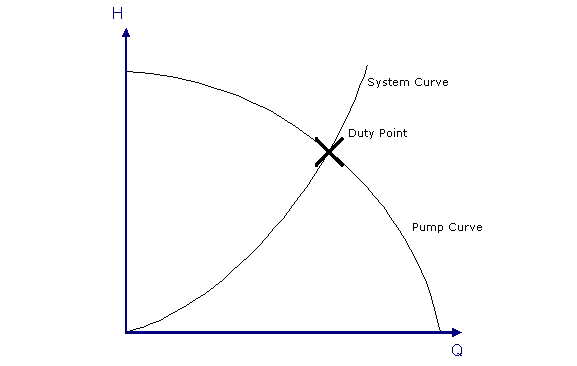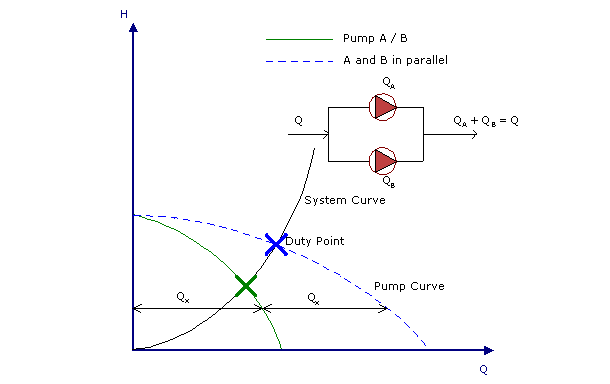Pump curve information
There is a description of the use of pumps within pumping stations in the About pumping stations section.
Pump information required is detailed in the Pump Curve Data Fields section.
Pump characteristic curves relate the performance characteristics of
the pump, typically pump head (HP),
power consumed (P), and efficiency (![]() ), to discharge (Q).
), to discharge (Q).

Pump Operating Characteristics
Pump characteristic data should be supplied by the manufacturer. These characteristics correspond to one-stage pumps and to the rated speed.
Characteristics of a multi-stage pump are calculated by multiplying head, HPand power, P by the number of stages.
System curve
The system curve relates the pumping head required, HP to discharge, Q. The operating point, (duty point), of the pump occurs where the system curve and the pump curve intersect.
As the mechanical parts of the pump deteriorate with use over time, the duty point of the pump will move (for a given head required the flow will decrease, i.e. the pump curve will move downwards). Also, as the system pipework deteriorates and becomes rougher, the system curve will become steeper. Over time, a significant decrease in pump output may occur.

Effect of wear on pump
If pump testing has been carried out since the pump was installed, the characteristics from the test results can be used to provide a more accurate, up to date curve for the pump. Alternatively, a throttle can be applied to the pumping station to simulate the deterioration of the pump.
Pumps in Parallel
Operating characteristics for a PST with two pumps in parallel are shown in the figures below:

Similar Pumps in Parallel

Dissimilar Pumps in Parallel
InfoWorks WS can handle stations with several units in parallel easily. More information is contained in the About pumping stations section.
Fixed Speed Pumps
These pumps are by far the most frequently used units in any water supply system. They are designed to operate at one rotational speed only.

The actual rotational speed of a pump may differ by a few percent from the rated speed, thus changing its characteristics, sometimes significantly. The user should find out the real value. InfoWorks WS will then compute the corresponding characteristic for every pump, applying the affinity laws.
Always remember that the motor determines the rotational speed of its pump, not the other way round.
Variable Speed Pumps
These pumps are designed to operate over a range of speeds. InfoWorks WS assumes that the speed may have any value within the given range: normally between 70% and 100% of rated speed. In rare cases this range is broader. InfoWorks WS will warn the user that the range is unusually wide.
Characteristics for different rotational speeds, can be predicted using the affinity laws. The affinity laws state that for a given impeller diameter:
|
|
where: Q = Discharge through pump station n = Rotational speed of impeller HP = Head P = Power “o” indicates rated value |


